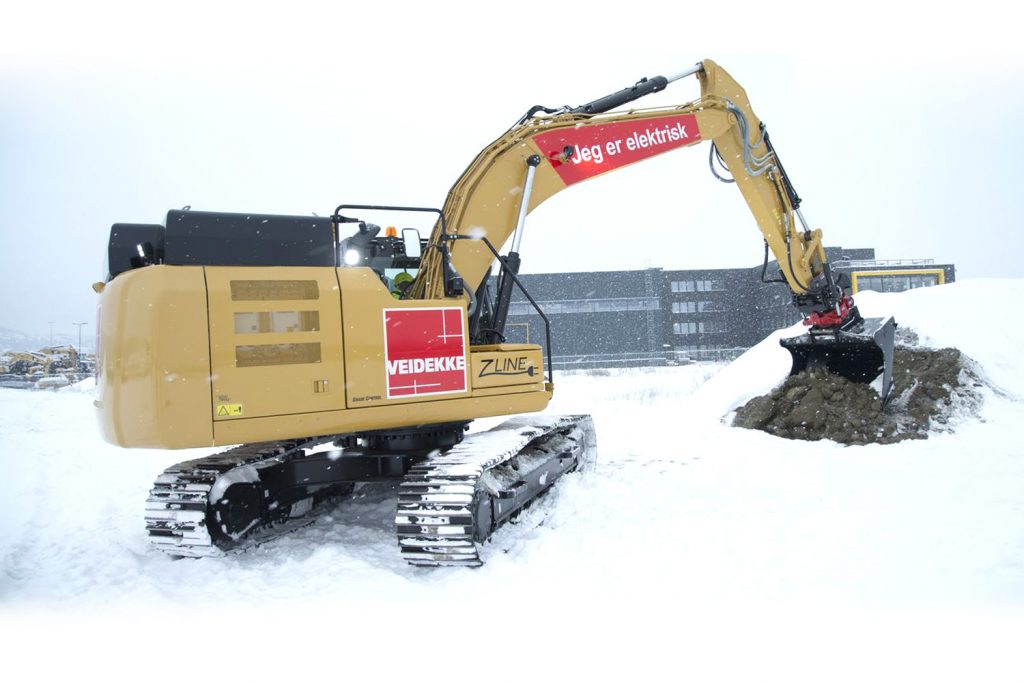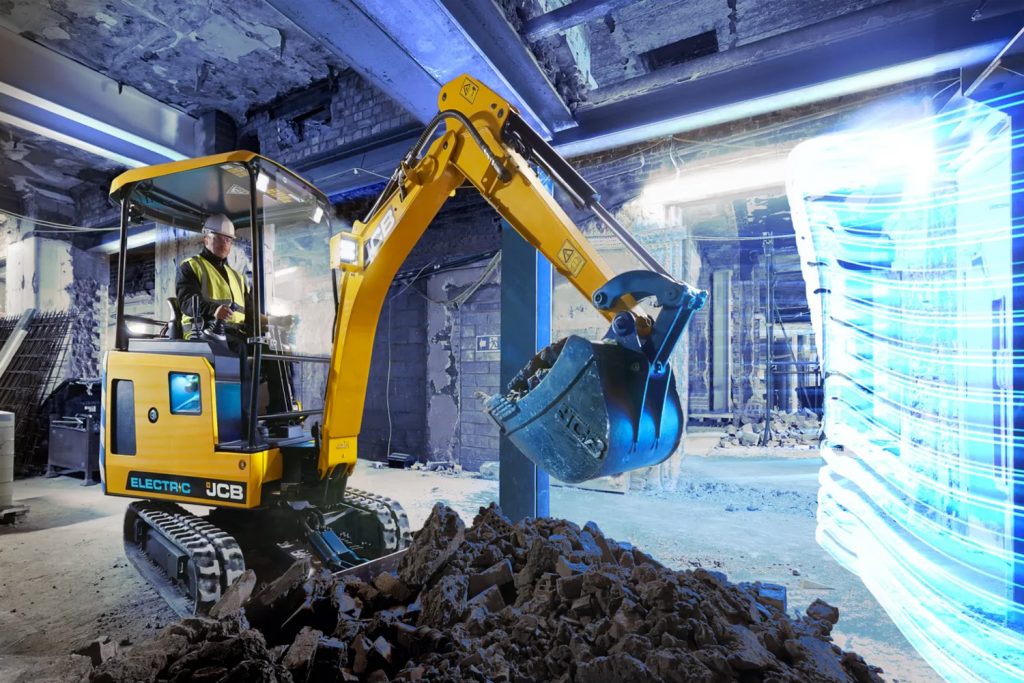Much has been written recently, here in Rail Engineer and elsewhere, about the railway’s aspirations in terms of reducing its carbon output. Diesel-free by 2040, zero-carbon by 2050, Scotland’s ambition to do it all by 2035, it’s a hot topic at present.
Proposed solutions include electric trains, hybrid trains, bi-mode trains, tri-mode trains, hydrogen-powered trains and even solar-powered trains.
But there is more to the railway than trains. The heavy plant that is used to maintain and renew the railway also runs on diesel and, as well as carbon emissions, the fumes themselves can cause problems when used in a confined space. Railway staff carrying out work in tunnels and in stations with large canopies or overall roofs have to deal with the emissions, sometimes even having to resort to breathing apparatus or forced ventilation.
So, it is no surprise that the major manufacturers of construction plant are looking at alternative power sources.
For years, fork lift trucks operating in warehouses and factories have been powered by liquefied gases such as propane. This reduces emissions, but it still produces carbon.
Battery power therefore seems the logical way to go. Cables aren’t practical, so an on-board source is needed, hence batteries.
Once again, this solution isn’t new. Vehicles of the ‘milk float’ type have been used for years, but the traditional lead-acid batteries that power them are heavy and slow to charge.

Individual cells
Dry-cell batteries, on the other hand, are light and charge more quickly. Developed to replace the original non-rechargeable zinc-carbon batteries that have been used in many types of torches, radios and other portable devices since 1900, the first popular iteration of a rechargeable battery was the nickel-cadmium (NiCd) version, which used nickel oxide hydroxide and cadmium as its two electrodes. Typical output of this chemistry is 1.2 volts, compared with 1.5V for the disposable original.
To overcome the small size and output of each cell, these new batteries were often fastened together in multiples to produce battery packs. Six cells produced 7.2 volts, seven 8.4 volts, and these packs often replaced traditional 9V zinc-carbon ‘alkaline’ batteries.
Even more powerful battery packs could be produced by simply combining larger numbers of battery cells. 14V and 28V standby-power units were common on aircraft, although these often also used a vented-cell construction, with the individual cells not sealed and any gases resulting from overcharging or rapid discharging being vented via a low-pressure relief valve.
However, NiCd batteries suffer from a ‘memory effect’. If they are never fully discharged, but are instead topped back up partway through the discharge cycle, they ‘remember’ this level and then won’t discharge any more, reducing the capacity of the cell.
They also contain between six and 18 per cent cadmium – a toxic heavy-metal which needs special disposal arrangements. The result is that the ‘emissions free’ equipment they power isn’t as ‘clean’ as it could have been.
As a result, nickel-cadmium batteries were replaced by nickel-metal-hydride (NiMH) batteries, in which the negative electrode was actually hydrogen ions, or protons, absorbed in a metallic lattice made of an alloy of various metals including ‘rare earths’. The capacity of a NiMH battery is two to three times that of the equivalent NiCd version. Output voltage is similar and they don’t suffer from the memory effect.
Replacing the nickel with lithium produced the lithium-ion battery (Li-ion), again with higher outputs. As each cell now produced 3.2-3.7 volts, they couldn’t be used as direct replacements for the earlier types. However, they were quick to charge, had no memory effect and a high energy density.
On the down side, the electrolyte was flammable, and early fires caused problems for Samsung Galaxy Note 7 mobile phones and Boeing 787 airliners.
A development of the Li-ion battery, patented in 2001, is the NMC, which uses lithium nickel manganese cobalt oxide for the positive electrode in place of the lithium cobalt/iron/manganese oxides of early examples, with the negative electrode being graphite or another carbon-based material. Electric vehicles such as the Nissan Leaf use this battery technology, with each 62kWh pack containing 288 individual cells.
More recently, LTO or lithium-titanate batteries use that material on the surface of their anodes in place of carbon. This allows electrons to enter and leave the electrode more quickly, permitting quicker recharges and giving longer life.
All of these developments in battery technology have resulted in the ability to make really powerful batteries that recharge quickly and don’t suffer from the memory effect that the early NiCd batteries did, and that enables the construction plant manufacturers to start developing new battery-powered machines.
Excavators
Already in production is the JCB 19C-1E fully electric mini excavator, which the manufacturer claims is the “industry’s first”.
The standard three-battery lithium-ion pack gives four hours of continuous use while the optional four-battery pack extends this to five hours of typical work. Battery status is displayed on a gauge on the instrument panel.
Four hours continuous use is claimed to represent a typical day’s work. Where railway access is limited, that should certainly be sufficient. Emissions are, of course, zero while the machine is six decibels quieter than the diesel-powered equivalent (decibels are logarithmic in scale, so a reduction of just 3dB is a halving of the noise energy).
While the mini-excavator may be considered too small for many rail jobs, it is ideal for limited-access work inside station buildings, culverts and the like.
For operators who want something larger, Pon Equipment in Norway has developed a battery version of a 25-tonne Caterpillar 323 hydraulic excavator. The 164hp (122kW) diesel engine has been replaced by an electric motor of similar output although, as the power curves of the two are completely different, the electric motor controls had to be adjusted so as not to over-pressurise the hydraulics.
Understandably, the battery is large. At 300kWh, its nearly five times larger than the 62kWh Nissan Leaf battery mentioned earlier (a Tesla S has a 100kWh battery – this is still three times larger than that). It also weighs an impressive 3.4 tonnes – the team reduced the mass of the conventional counterweight to compensate for it.
The prototype took Pon Equipment eight months to develop. Veidekke, Norway’s largest construction and civil-engineering company, has since bought eight of them for a reputed NOK5.5 million (£470,000) each.
Øivind Larsen, plant director at Veidekke, explained his purchase to consumer technology website Tek.no: “For us, it is important to use new technology that helps reduce emissions from our machinery, and not least improve the everyday life of those who use the machines,” adding that the machine they have now purchased will reduce CO2 emissions by around 52 tonnes.

Bigger and bigger
If a 25-tonne excavator is not big enough, how about a Komatsu HD605-7 off-highway truck, which weighs 51 tonnes unladen and has a payload of 63 tonnes? Kuhn Switzerland, working with Lithium Storage and the Swiss Federal Office of Energy (SFOE), has converted this 111-tonne gross vehicle weight monster into an electric vehicle.
Out came the 23-litre, 778hp (578kW) diesel engine and in went a synchronous electric motor rated at 789hp (588kW) electric motors. An additional 120kW motor is fitted just to power the hydraulic systems. The battery was a challenge – the four large packs have a combined rating of 700kWh and weigh 4.5 tonnes.
One good thing about these large dump trucks is that they run from the bottom of a quarry to the top – and back again. So, while it expends quite a lot of energy hauling its massive load up a gradient that is typically 1 in 12, it can regenerate almost as much while running back down empty. As a result, the batteries only need recharging once every three days.
Now in service with Ciments Vigier at its quarry near Péry, Switzerland, the eDumper was developed using bespoke technology. The motor (manufactured by Oswald Motoren), the transmission (Puls Getriebe), the batteries (Lithium Storage) and the inverter (Aradex) are all new designs, based on the latest generation of industrial products.

While an eDumper may be too large to use on the railway, it does show what can now be done. Between JCB’s mini-excavator and eMining’s dump truck, there is room to battery-power almost any item used on the railway today.
Volvo’s contribution
Smaller and lighter equipment is getting the treatment first – the batteries and motors can be smaller. Volvo Construction Equipment has already supplied its first electric compact loader, to a customer in Germany.
The Volvo L25 Electric is powered by lithium-ion batteries that cover an eight-hour working shift with one single charge in the machine’s regular applications, which include light infrastructure work, gardening, landscaping and agriculture. The L25 also incorporates two dedicated electric motors – one for the drivetrain and one of the hydraulics. Decoupling the subsystems has led to higher efficiency across the entire machine.
Meantime, the company has also delivered its first ECR25 electric compact excavator to French contractor Spac, part of the Colas Group.
By mid-2020, the company says it will begin to launch a range of electric compact excavators (EC15 to EC27) and electric wheel loaders (L20 to L28), and will be stopping development of new-based models in these ranges.
In parallel, Volvo CE says it will keep working to find additional opportunities for electromobility across all its product ranges and applications. “We want to be able to offer our customers clean, efficient solutions that deliver on performance and productivity. We want to be able to offer responsible, sustainable products, a clear path to a better tomorrow.”
More to come
These new machines are only the tip of the ‘electric’ iceberg. As pressure mounts to cut carbon emissions and to protect workers from harmful fumes, there will be more to come.
Eurotunnel awarded a contract in 2018 to specialist rail equipment manufacturer Socofer to design and build 19 battery shunting locomotives. Aegis Engineering Systems will support Eurotunnel overseeing the standards and approval strategy. The first operational battery shunting locomotive will be delivered during 2020 followed by one per month until the order is complete.
A spokesperson said that replacement of diesel shunting locomotives with battery shunting locomotives, together with an ongoing related project to replace diesel generators with battery packs, will deliver a monumental step forward in Eurotunnel’s goal to eliminate all carbon emissions during maintenance works and improve the atmospheric conditions for Eurotunnel’s employees during maintenance activities.

UK railway regulator the Office of Rail and Road has issued guidance on reducing diesel engine exhaust emissions (DEEE) in the railway sector. Although much of this refers to the exhaust from diesel railway locomotives, some of it does also apply to plant being used to maintain and enhance the railway.
In a written statement, the ORR said: “We expect rail companies to minimise worker exposures to DEEE in tunnels (and elsewhere) by substitution (for electrical equipment) where this is reasonably practicable.
“However, we recognise that this may not always be possible and that alternative controls (for example siting equipment outside the tunnel; reducing emissions by use of particulate filters and selective catalyst reduction on the exhaust where possible; provision of forced ventilation through the tunnel; and powered respiratory equipment for workers) should be provided. The control solutions will depend on the extent and duration of the task.
“We have seen examples of innovation in tunnel working, with trials of battery powered access equipment for regular inspection work in long tunnels.”
It seems that ‘battery is the new diesel’. It will be fascinating to see how this sector develops over the next few years.


